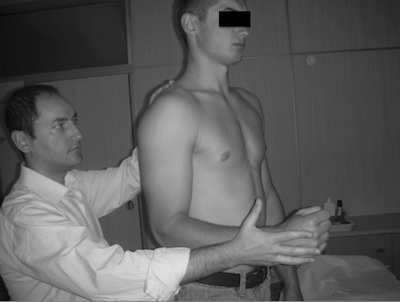Infraspinatus scapular retraction test: a reliable and practical method to assess infraspinatus strength in overhead athletes with scapular dyskinesis.
Authors: Merolla G, De Santis E, Campi F, Paladini P, Porcellini G.
References: J Orthop Traumatol. 2010 Jun;11(2):105-10. Epub 2010 Jun 1.
BACKGROUND: Alteration of normal scapulohumeral rhythm due to the fatigue of scapular-stabilizing muscles induces decrease of rotator cuff strength. In this study we analyzed the interobserver and intraobserver realibility of the infraspinatus strength test (IST) and infraspinatus scapular retraction test (ISRT) in 29 overhead athletes with scapular dyskinesis, before and after 6 months of scapular musculature rehabilitation.
MATERIALS AND METHODS: Subjects with magnetic resonance imaging (MRI) findings of labral injuries (2 cases, 5%) and cuff tears (4 cases, 11%) were excluded. Scapular dyskinesis patterns were evaluated according to Kibler et al. (J Shoulder Elbow Surg 11:550-556, 2002). We found a type I dyskinesis in 24 cases (83%) and a type II in 5 cases (17%). Patients were tested by using IST and ISRT and the maximum infraspinatus strength (kg) was registered by a handheld dynamometer. Changes in shoulder IR were measured by using a standard goniometry. Rehabilitation continued for 6 months and was focused on the restoration of scapular muscular control and balance. We used a paired Student t test for the significance of the force values (alpha = 0.01). Intraclass correlation coefficient (ICC) and standard error (SE) were applied to determine the realibility of repeated values collected within testers and between testers.
RESULTS: Values of ICC close to 1 at baseline and at 6 months indicated a higher interexaminer and intraexaminer realibility. IST force values registered a significant increase at 6 months for both examiners (P < 0.01). The mean difference between IST and ISRT values were not significant at 6 months (P > 0.01). The increase of glenohumeral internal rotation was significant at 6 months (P < 0.01).
CONCLUSION: The good reliability and the easy reproducibility make the ISRT an excellent test to assess patients with infraspinatus weakness due to scapular dyskinesis and address them toward an appropriate program of rehabilitation aimed to restore scapular musculature balance and control.



